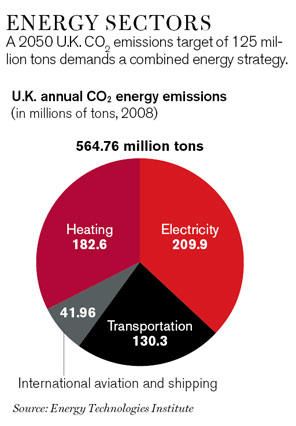Everything Is the Grid
Smart grids alone could help curb the need for additional power plants and decrease carbon emissions. But they’ll do even more good where they can be combined with new heating and transportation systems, whether that’s on the scale of an individual building or of an entire city.

“In most places we’ve got completely separate power, heat, and transport systems,” says David Clarke, CEO of the U.K.’s Energy Technologies Institute, an organization jointly funded by industry and the British government. Because power generation appears to be the easiest energy system to “decarbonize,” Clarke foresees that nearly all heating and transportation will eventually be brought under the electrical umbrella, through technologies such as electric vehicles and residential heat pumps that use the air or ground as a heat source or sink.
Before that all-electric future arrives, Japan is testing other technologies to reduce urban energy demand by better integrating power and heating systems. It is spending a billion dollars in four cities over five years to develop and deploy technologies such as residential natural-gas fuel cells: the cells reduce the amount of power the grid must supply, while waste heat from the fuel cell is used to warm the house. When electricity and heat are both generated on-site in this way, a house requires less total energy than it would if warmed and powered separately.
Keep Reading
Most Popular
Large language models can do jaw-dropping things. But nobody knows exactly why.
And that's a problem. Figuring it out is one of the biggest scientific puzzles of our time and a crucial step towards controlling more powerful future models.
The problem with plug-in hybrids? Their drivers.
Plug-in hybrids are often sold as a transition to EVs, but new data from Europe shows we’re still underestimating the emissions they produce.
Google DeepMind’s new generative model makes Super Mario–like games from scratch
Genie learns how to control games by watching hours and hours of video. It could help train next-gen robots too.
How scientists traced a mysterious covid case back to six toilets
When wastewater surveillance turns into a hunt for a single infected individual, the ethics get tricky.
Stay connected
Get the latest updates from
MIT Technology Review
Discover special offers, top stories, upcoming events, and more.